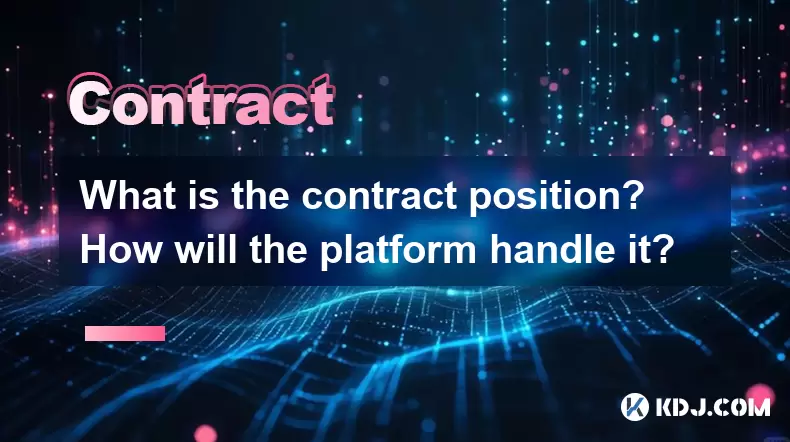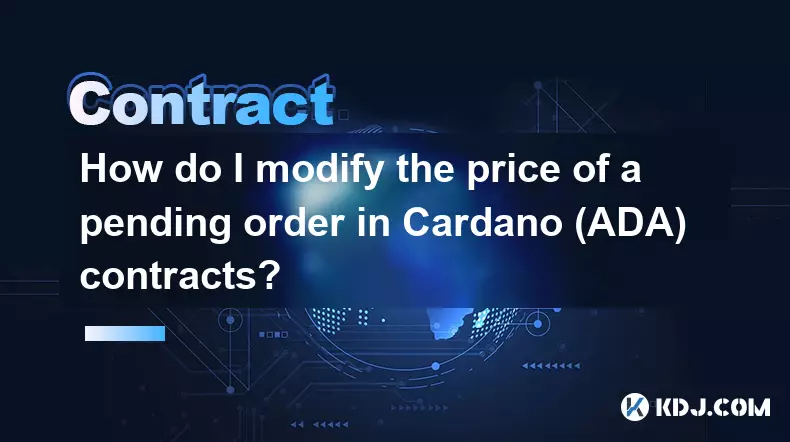-
 bitcoin
bitcoin $109523.663807 USD
-0.13% -
 ethereum
ethereum $4019.526508 USD
2.06% -
 tether
tether $1.000482 USD
0.00% -
 xrp
xrp $2.776815 USD
0.18% -
 bnb
bnb $958.942396 USD
0.12% -
 solana
solana $204.294698 USD
3.84% -
 usd-coin
usd-coin $0.999693 USD
0.00% -
 dogecoin
dogecoin $0.232115 USD
2.09% -
 tron
tron $0.338028 USD
0.84% -
 cardano
cardano $0.790920 USD
1.50% -
 hyperliquid
hyperliquid $44.871443 USD
5.60% -
 ethena-usde
ethena-usde $1.000322 USD
0.04% -
 chainlink
chainlink $21.034165 USD
2.60% -
 avalanche
avalanche $28.794831 USD
-0.54% -
 stellar
stellar $0.360466 USD
1.24%
What is the contract position? How will the platform handle it?
A contract position in crypto futures represents an open trade with defined terms, requiring careful management of margin, leverage, and liquidation risks.
Jun 22, 2025 at 03:56 pm

Understanding the Concept of a Contract Position
In the realm of cryptocurrency trading, particularly within futures and derivatives markets, a contract position refers to the open trade that a trader holds at any given time. This can be either a long position, where the trader expects the price of an asset to rise, or a short position, where the trader anticipates a decline in value. Each contract position represents an agreement between two parties to buy or sell a specific amount of cryptocurrency at a predetermined price on a future date.
The contract size varies depending on the platform and the specific asset being traded. For example, on some platforms, one Bitcoin futures contract might represent 1 BTC, while on others, it could be a fraction or multiple thereof. Traders must understand the exact specifications of the contracts they are engaging with before entering any position.
How Platforms Handle Open Contract Positions
Cryptocurrency trading platforms manage contract positions through automated systems that track each user's trades in real-time. When a trader opens a position, the platform records key details such as the entry price, leverage used, margin requirements, and liquidation price. These data points are crucial for determining the profit and loss (P&L) of the position and whether the trader has sufficient margin to maintain the trade.
Platforms also use mark price mechanisms to ensure that unrealized profits and losses are calculated accurately based on fair market value rather than potentially manipulated spot prices. This helps prevent unnecessary liquidations and ensures that traders' positions reflect true market conditions.
Additionally, platforms implement auto-deleveraging (ADL) systems to handle situations where a trader's position cannot be closed due to insufficient liquidity or when the insurance fund is not enough to cover losses. Under ADL, profitable traders may have their positions partially reduced to offset losses from bankrupt traders.
Liquidation of Contract Positions
One of the most critical aspects of holding a contract position is understanding liquidation. If a trader's equity (account balance plus unrealized P&L) falls below the required maintenance margin, the platform will automatically close the position to prevent further losses. The liquidation price is the price at which this forced closure occurs.
Each platform calculates liquidation differently, often factoring in leverage, initial margin, and fees. Some platforms provide liquidation price calculators to help traders assess risk before opening a position. It's essential for traders to monitor their margin ratio and unrealized P&L constantly to avoid unexpected liquidations.
Moreover, platforms typically display liquidation levels in real-time on the trading interface, allowing users to adjust their positions accordingly. Some exchanges also offer partial liquidation, where only a portion of the position is closed to bring the margin back to acceptable levels instead of closing the entire trade.
Position Management Tools Available to Users
To give traders more control over their contract positions, platforms offer several tools:
- Take Profit / Stop Loss Orders: These allow traders to set automatic exits for their positions based on predefined price levels.
- Trailing Stop Orders: These dynamically adjust the stop-loss level as the market moves in favor of the trader.
- Margin Adjustment: Many platforms let users increase or decrease the margin allocated to a specific position, helping manage risk exposure.
- Position Hedging: Some platforms support hedging strategies, allowing traders to hold both long and short positions simultaneously on the same asset.
These features are usually accessible via the trading interface under the “Positions” tab. Users should explore these options thoroughly to optimize their trading strategy and minimize potential losses.
Real-Time Monitoring and Notifications
Modern crypto derivative platforms provide real-time dashboards that show all active contract positions, including current profit/loss, mark price, funding rates, and estimated liquidation levels. These dashboards update continuously and are often customizable to suit individual preferences.
Additionally, many platforms offer mobile notifications and email alerts to inform users about significant events related to their positions, such as approaching liquidation levels, changes in funding rates, or triggered take-profit/stop-loss orders.
Some advanced platforms integrate APIs that allow experienced traders to connect third-party monitoring tools or custom scripts to automate alerts and even execute trades remotely. Proper use of these tools enhances risk management and allows traders to react swiftly to changing market conditions.
Frequently Asked Questions
What happens if my position gets fully liquidated?When your position is fully liquidated, the platform closes your trade forcibly at the liquidation price. Your remaining account balance after covering losses depends on the platform’s insurance fund and whether auto-deleveraging was triggered.
Can I reduce the leverage on an existing position?Yes, most platforms allow you to adjust the leverage on an open position. This feature is usually found in the 'Positions' section of the trading interface. Reducing leverage increases your maintenance margin buffer and lowers the risk of liquidation.
Do all platforms calculate liquidation prices the same way?No, different platforms use varying formulas and parameters, such as maintenance margin percentages and fee structures, to calculate liquidation prices. Always check the specific rules of the exchange you're using.
Is it possible to reopen a position immediately after liquidation?Yes, unless your account has been flagged for excessive risk or policy violations, you can open new positions right after a liquidation. However, it's advisable to reassess your strategy before re-entering the market.
Disclaimer:info@kdj.com
The information provided is not trading advice. kdj.com does not assume any responsibility for any investments made based on the information provided in this article. Cryptocurrencies are highly volatile and it is highly recommended that you invest with caution after thorough research!
If you believe that the content used on this website infringes your copyright, please contact us immediately (info@kdj.com) and we will delete it promptly.
- Whales, Trump Coin, and Crypto: A New York Minute on What's Hot (and What's Not)
- 2025-09-27 10:25:17
- SWIFT Tests On-Chain Messaging with Linea: A New Era for Global Finance?
- 2025-09-27 10:25:17
- Binance Coin, WLFI, Crypto Presales: Decoding 2025's Hottest Trends
- 2025-09-27 10:45:15
- MoonBull, Crypto, and Snek Cheems: Navigating the Meme Coin Mania in 2025
- 2025-09-27 10:30:02
- Dogecoin's Rocky Road: Resistance and Price Decline - What's Next?
- 2025-09-27 10:45:15
- Meme Coins: Will Dogecoin and Shiba Inu Ever See Another Boom?
- 2025-09-27 10:50:01
Related knowledge

How do I enable the "scalping-only" mode for Cardano (ADA) contracts?
Sep 24,2025 at 03:19am
Understanding Scalping Strategies in Crypto Derivatives1. Scalping in cryptocurrency trading refers to executing multiple short-term trades within min...

What is the maximum position limit for Cardano (ADA) contracts?
Sep 23,2025 at 11:00pm
Understanding ADA Futures and Derivatives Market Structure1. Cardano (ADA) futures contracts are offered by several major cryptocurrency derivatives e...

What is the maker fee for Cardano (ADA) contracts?
Sep 26,2025 at 09:01am
Understanding Maker Fees in Cardano (ADA) Contracts1. The concept of maker fees applies broadly across decentralized exchanges and smart contract plat...

How can I view open interest in Cardano (ADA) contracts?
Sep 24,2025 at 07:36am
Understanding Open Interest in Cardano Derivatives1. Open interest refers to the total number of outstanding derivative contracts, such as futures or ...

How do I modify the price of a pending order in Cardano (ADA) contracts?
Sep 27,2025 at 01:00am
Understanding Pending Orders in Cardano Smart Contracts1. Cardano operates on a proof-of-stake blockchain that supports smart contracts through its Pl...

What is the function of the insurance fund in Cardano (ADA) contracts?
Sep 24,2025 at 02:18am
Understanding the Role of Insurance Funds in Cardano Smart Contracts1. The insurance fund within Cardano's ecosystem is not a native feature directly ...

How do I enable the "scalping-only" mode for Cardano (ADA) contracts?
Sep 24,2025 at 03:19am
Understanding Scalping Strategies in Crypto Derivatives1. Scalping in cryptocurrency trading refers to executing multiple short-term trades within min...

What is the maximum position limit for Cardano (ADA) contracts?
Sep 23,2025 at 11:00pm
Understanding ADA Futures and Derivatives Market Structure1. Cardano (ADA) futures contracts are offered by several major cryptocurrency derivatives e...

What is the maker fee for Cardano (ADA) contracts?
Sep 26,2025 at 09:01am
Understanding Maker Fees in Cardano (ADA) Contracts1. The concept of maker fees applies broadly across decentralized exchanges and smart contract plat...

How can I view open interest in Cardano (ADA) contracts?
Sep 24,2025 at 07:36am
Understanding Open Interest in Cardano Derivatives1. Open interest refers to the total number of outstanding derivative contracts, such as futures or ...

How do I modify the price of a pending order in Cardano (ADA) contracts?
Sep 27,2025 at 01:00am
Understanding Pending Orders in Cardano Smart Contracts1. Cardano operates on a proof-of-stake blockchain that supports smart contracts through its Pl...

What is the function of the insurance fund in Cardano (ADA) contracts?
Sep 24,2025 at 02:18am
Understanding the Role of Insurance Funds in Cardano Smart Contracts1. The insurance fund within Cardano's ecosystem is not a native feature directly ...
See all articles










































































